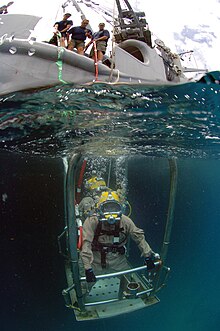
In underwater diving, ascending and descending is done using strict protocols to avoid problems caused by the changes in ambient pressure and the hazards of obstacles near the surface such as collision with vessels. Diver certification and accreditation organisations place importance on these protocols early in their diver training programmes.[1] Ascent and descent are historically the times when divers are injured most often when failing to follow appropriate procedure.
The procedures vary depending on whether the diver is using scuba or surface supplied equipment. Scuba divers control their own descent and ascent rate, while surface supplied divers may control their own ascents and descents, or be lowered and lifted by the surface team, either by their umbilical, or on a diving stage, or in a diving bell.
Descent rates are usually limited by equalisation issues, particularly with ears and sinuses, but on helmet dives can be limited by flow rate of gas available for equalising the helmet and suit, by carbon dioxide buildup caused by inadequate exhalation, and for divers breathing heliox at great depths, by high-pressure nervous syndrome. Ascents of divers breathing at ambient pressure are normally limited by decompression risk, but also to a far lesser extent, by lung overpressure injury risk. Historically there has been considerable change in the recommended maximum ascent rate, mostly to limit risk of decompression sickness.
Freedivers are less limited by equipment, and in extreme events may use heavy ballast to accelerate descent, and an inflatable lift bag to accelerate ascent, as they do not normally stay under pressure long enough to be affected by decompression issues. Atmospheric pressure suit divers are physiologically unaffected by the external pressure. Their rates of ascent and descent are limited by equipment deployment and recovery factors.